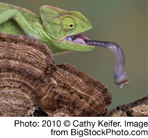

 Chameleons are amazing animals incredibly designed to
feed in a remarkable way. Chameleons eat bugs. They do so by shooting
their tongues out of their body and snagging the bug. Some chameleons
can extend their tongues twice their body length and can do so in .07
seconds. Most of us know that frogs do something similar to this, but
the chameleon has some remarkable design features that allow it to
function in ways different from frogs. Chameleons have legs that allow
them to climb and grip limbs or twigs. They have a tail that can be
wrapped around a limb or twig for leverage and balance. Their skin can
change color to match the environment they are in, giving them a very
high level of camouflage.
Chameleons are amazing animals incredibly designed to
feed in a remarkable way. Chameleons eat bugs. They do so by shooting
their tongues out of their body and snagging the bug. Some chameleons
can extend their tongues twice their body length and can do so in .07
seconds. Most of us know that frogs do something similar to this, but
the chameleon has some remarkable design features that allow it to
function in ways different from frogs. Chameleons have legs that allow
them to climb and grip limbs or twigs. They have a tail that can be
wrapped around a limb or twig for leverage and balance. Their skin can
change color to match the environment they are in, giving them a very
high level of camouflage.
Two of the most remarkable characteristics of the chameleon are its
eyes and brain. The eyes can either work together or independently.
They are located in ball sockets that rotate and the animal can look
two completely different directions at once, thus finding prey and
avoiding enemies in a highly efficient way. When the chameleon finds
prey, both eyes will point toward the prey giving the chameleon
stereoscopic vision which allows it to judge distance accurately and
capture its food. For the eyes to be able to function both
independently and together is unlike almost all other forms of life.
Recently researchers at the University of South Florida reported
another amazing design in the chameleon. It had been noticed that even
in very cold weather the chameleon could function even though it is a
cold-blooded reptile. Why did the cold not slow down its ability to
catch prey? It turns out that the tongue is made of collagen which
uncoils on the basis of momentum, not muscle strength. This means that
no muscles have to be used to get the prey. Reeling the tongue back in
was significantly slowed (up to 63 percent), but that is not an issue
in catching the prey. This animal, remarkably designed to secure its
prey in a variety of conditions, speaks of a designer that used unique
materials and engineering.
Source: Scientific American,
May 2010, page 18, and online in the March 8, 2010 Proceedings of the National Academy of
Sciences.
Back to Contents
Does God Exist?, NovDec10.



 Chameleons are amazing animals incredibly designed to
feed in a remarkable way. Chameleons eat bugs. They do so by shooting
their tongues out of their body and snagging the bug. Some chameleons
can extend their tongues twice their body length and can do so in .07
seconds. Most of us know that frogs do something similar to this, but
the chameleon has some remarkable design features that allow it to
function in ways different from frogs. Chameleons have legs that allow
them to climb and grip limbs or twigs. They have a tail that can be
wrapped around a limb or twig for leverage and balance. Their skin can
change color to match the environment they are in, giving them a very
high level of camouflage.
Chameleons are amazing animals incredibly designed to
feed in a remarkable way. Chameleons eat bugs. They do so by shooting
their tongues out of their body and snagging the bug. Some chameleons
can extend their tongues twice their body length and can do so in .07
seconds. Most of us know that frogs do something similar to this, but
the chameleon has some remarkable design features that allow it to
function in ways different from frogs. Chameleons have legs that allow
them to climb and grip limbs or twigs. They have a tail that can be
wrapped around a limb or twig for leverage and balance. Their skin can
change color to match the environment they are in, giving them a very
high level of camouflage.